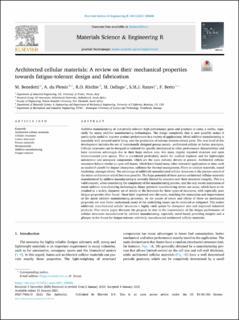| dc.contributor.author | Benedetti, M. | |
| dc.contributor.author | Du Plessis, Anton | |
| dc.contributor.author | Ritchie, R.O. | |
| dc.contributor.author | Dallago, M. | |
| dc.contributor.author | Razavi, Seyed Mohammad Javad | |
| dc.contributor.author | Berto, Filippo | |
| dc.date.accessioned | 2022-07-07T07:59:36Z | |
| dc.date.available | 2022-07-07T07:59:36Z | |
| dc.date.created | 2021-06-08T15:46:16Z | |
| dc.date.issued | 2021 | |
| dc.identifier.citation | Materials science & engineering. R, Reports. 2021, 144 . | en_US |
| dc.identifier.issn | 0927-796X | |
| dc.identifier.uri | https://hdl.handle.net/11250/3003378 | |
| dc.description.abstract | Additive manufacturing of industrially-relevant high-performance parts and products is today a reality, especially for metal additive manufacturing technologies. The design complexity that is now possible makes it particularly useful to improve product performance in a variety of applications. Metal additive manufacturing is especially well matured and is being used for production of end-use mission-critical parts. The next level of this development includes the use of intentionally designed porous metals - architected cellular or lattice structures. Cellular structures can be designed or tailored for specific mechanical or other performance characteristics and have numerous advantages due to their large surface area, low mass, regular repeated structure and open interconnected pore spaces. This is considered particularly useful for medical implants and for lightweight automotive and aerospace components, which are the main industry drivers at present. Architected cellular structures behave similar to open cell foams, which have found many other industrial applications to date, such as sandwich panels for impact absorption, radiators for thermal management, filters or catalyst materials, sound insulation, amongst others. The advantage of additively manufactured cellular structures is the precise control of the micro-architecture which becomes possible. The huge potential of these porous architected cellular materials manufactured by additive manufacturing is currently limited by concerns over their structural integrity. This is a valid concern, when considering the complexity of the manufacturing process, and the only recent maturation of metal additive manufacturing technologies. Many potential manufacturing errors can occur, which have so far resulted in a widely disparate set of results in the literature for these types of structures, with especially poor fatigue properties often found. These have improved over the years, matching the maturation and improvement of the metal additive manufacturing processes. As the causes of errors and effects of these on mechanical properties are now better understood, many of the underlying issues can be removed or mitigated. This makes additively manufactured cellular structures a highly valid option for disruptive new and improved industrial products. This review paper discusses the progress to date in the improvement of the fatigue performance of cellular structures manufactured by additive manufacturing, especially metal-based, providing insights and a glimpse to the future for fatigue-tolerant additively manufactured architected cellular materials. | en_US |
| dc.language.iso | eng | en_US |
| dc.publisher | Elsevier | en_US |
| dc.rights | Attribution-NonCommercial-NoDerivatives 4.0 Internasjonal | * |
| dc.rights.uri | http://creativecommons.org/licenses/by-nc-nd/4.0/deed.no | * |
| dc.title | Architected cellular materials: A review on their mechanical properties towards fatigue-tolerant design and fabrication | en_US |
| dc.type | Peer reviewed | en_US |
| dc.type | Journal article | en_US |
| dc.description.version | publishedVersion | en_US |
| dc.source.pagenumber | 40 | en_US |
| dc.source.volume | 144 | en_US |
| dc.source.journal | Materials science & engineering. R, Reports | en_US |
| dc.identifier.doi | 10.1016/j.mser.2021.100606 | |
| dc.identifier.cristin | 1914620 | |
| cristin.ispublished | true | |
| cristin.fulltext | original | |
| cristin.qualitycode | 1 | |

